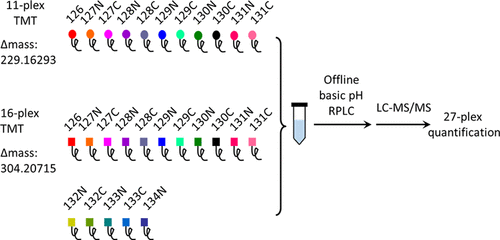当前位置:
X-MOL 学术
›
Anal. Chem.
›
论文详情
Our official English website, www.x-mol.net, welcomes your
feedback! (Note: you will need to create a separate account there.)
27-Plex Tandem Mass Tag Mass Spectrometry for Profiling Brain Proteome in Alzheimer's Disease.
Analytical Chemistry ( IF 6.7 ) Pub Date : 2020-05-07 , DOI: 10.1021/acs.analchem.0c00655 Zhen Wang 1 , Kaiwen Yu 1 , Haiyan Tan 2 , Zhiping Wu 1 , Ji-Hoon Cho 2 , Xian Han 1, 3 , Huan Sun 1 , Thomas G Beach 4 , Junmin Peng 1, 2
Analytical Chemistry ( IF 6.7 ) Pub Date : 2020-05-07 , DOI: 10.1021/acs.analchem.0c00655 Zhen Wang 1 , Kaiwen Yu 1 , Haiyan Tan 2 , Zhiping Wu 1 , Ji-Hoon Cho 2 , Xian Han 1, 3 , Huan Sun 1 , Thomas G Beach 4 , Junmin Peng 1, 2
Affiliation

|
Multiplexed isobaric labeling methods, such as tandem mass tags (TMT), remarkably improve the throughput of quantitative mass spectrometry. Here, we present a 27-plex TMT method coupled with two-dimensional liquid chromatography (LC/LC) for extensive peptide fractionation and high-resolution tandem mass spectrometry (MS/MS) for peptide quantification and then apply the method to profile the complex human brain proteome of Alzheimer's disease (AD). The 27-plex method combines multiplexed capacities of the 11-plex and the 16-plex TMT, as the peptides labeled by the two TMT sets display different mass and hydrophobicity, which can be well separated in LC-MS/MS. We first systematically optimized the protocol for the newly developed 16-plex TMT, including labeling reaction, desalting, and MS conditions, and then directly compared the 11-plex and 16-plex methods by analyzing the same human AD samples. Both methods yielded similar proteome coverage, analyzing >100 000 peptides in >10 000 human proteins. Furthermore, the 11-plex and 16-plex samples were mixed for a 27-plex assay, resulting in more than 8000 protein measurements within the same MS time. The 27-plex results are highly consistent with those of the individual 11-plex and 16-plex TMT analyses. We also used these proteomics data sets to compare the AD brain with the nondementia controls, discovering major AD-related proteins and revealing numerous novel protein alterations enriched in the pathways of amyloidosis, immunity, mitochondrial, and synaptic functions. Overall, our data strongly demonstrate that this new 27-plex strategy is highly feasible for routine large-scale proteomic analysis.
中文翻译:

用于分析阿尔茨海默氏病脑蛋白质组的 27 重串联质量标签质谱法。
多重同量异位标记方法,例如串联质量标签 (TMT),可显着提高定量质谱分析的通量。在这里,我们提出了一种 27 重 TMT 方法,结合二维液相色谱 (LC/LC) 进行广泛的肽分级分离和高分辨率串联质谱 (MS/MS) 进行肽定量,然后应用该方法来分析复合物阿尔茨海默病(AD)的人脑蛋白质组。 27 重方法结合了 11 重和 16 重 TMT 的多重能力,因为两个 TMT 组标记的肽显示出不同的质量和疏水性,可以在 LC-MS/MS 中很好地分离。我们首先系统地优化了新开发的16-plex TMT的方案,包括标记反应、脱盐和MS条件,然后通过分析相同的人类AD样本直接比较11-plex和16-plex方法。两种方法都得到了相似的蛋白质组覆盖率,分析了 >10 000 人类蛋白质中的 >100 000 肽。此外,将 11 重和 16 重样品混合进行 27 重测定,从而在同一 MS 时间内进行超过 8000 次蛋白质测量。 27 重结果与各个 11 重和 16 重 TMT 分析的结果高度一致。我们还使用这些蛋白质组学数据集将 AD 大脑与非痴呆对照进行比较,发现了与 AD 相关的主要蛋白质,并揭示了淀粉样变性、免疫、线粒体和突触功能途径中丰富的许多新蛋白质改变。总的来说,我们的数据有力地证明了这种新的 27 重策略对于常规大规模蛋白质组分析是高度可行的。
更新日期:2020-04-28
中文翻译:

用于分析阿尔茨海默氏病脑蛋白质组的 27 重串联质量标签质谱法。
多重同量异位标记方法,例如串联质量标签 (TMT),可显着提高定量质谱分析的通量。在这里,我们提出了一种 27 重 TMT 方法,结合二维液相色谱 (LC/LC) 进行广泛的肽分级分离和高分辨率串联质谱 (MS/MS) 进行肽定量,然后应用该方法来分析复合物阿尔茨海默病(AD)的人脑蛋白质组。 27 重方法结合了 11 重和 16 重 TMT 的多重能力,因为两个 TMT 组标记的肽显示出不同的质量和疏水性,可以在 LC-MS/MS 中很好地分离。我们首先系统地优化了新开发的16-plex TMT的方案,包括标记反应、脱盐和MS条件,然后通过分析相同的人类AD样本直接比较11-plex和16-plex方法。两种方法都得到了相似的蛋白质组覆盖率,分析了 >10 000 人类蛋白质中的 >100 000 肽。此外,将 11 重和 16 重样品混合进行 27 重测定,从而在同一 MS 时间内进行超过 8000 次蛋白质测量。 27 重结果与各个 11 重和 16 重 TMT 分析的结果高度一致。我们还使用这些蛋白质组学数据集将 AD 大脑与非痴呆对照进行比较,发现了与 AD 相关的主要蛋白质,并揭示了淀粉样变性、免疫、线粒体和突触功能途径中丰富的许多新蛋白质改变。总的来说,我们的数据有力地证明了这种新的 27 重策略对于常规大规模蛋白质组分析是高度可行的。


















































 京公网安备 11010802027423号
京公网安备 11010802027423号